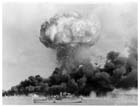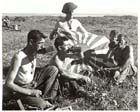 Attitudes to the war Australian attitudes to the Japanese |
The first section reveals the derogatory pre-war stereotypes of the Japanese held by the men who would soon be facing them on the battlefield. Those stereotypes were rudely shattered by the scale and swiftness of Japan’s victories against the Allies in the first half of 1942 and the second section deals with the Australians reassessment of the fighting ability of the Japanese forces. While many Australians came, however grudgingly, to respect the bravery of their Japanese opponents, this attitude was tempered by their horror and outrage at the Japanese atrociticies committed against Australian prisoners of war and others. The impact of these atrocities on Australian servicemen is examined in section three. This reaction was closely tied to the Australian's own treatment of Japanese prisoners of war and this is the subject of the fourth section. The fifth section looks at the reaction of Australians to the use of the atomic bomb against Hiroshima and Nagasaki. Finally the last section deals with the attitudes of Australian veterans towards the Japanese after the war ended.
All of the statements included in this site have been taken from transcripts of interviews conducted with Australian Second World War veterans in the late 1980s and early 1990s and held in the Australian War Memorial's collection as part of the Keith Murdoch sound archive.
Australian Attitudes links
 Australian Attitudes
Australian Attitudes Pre-war perceptions
Pre-war perceptions  Fighting Ability
Fighting Ability  Atrocities
Atrocities  Japanese POWs
Japanese POWs  Atomic Bomb
Atomic Bomb  Post-war
Post-war
Attitudes links
| Overview | ||
| Australian Attitudes | ||
| Tamura diary | ||
| Southern Cross | ||
| Midget Submarine | ||
Click images to enlarge.

AWM 127896

AWM 128108

AWM 015776
The AJRP has wound up its activities at the Memorial for the moment. Please contact the relevant officer of the Australian War Memorial for assistance. Internet implementation by Fulton Technology and AJRP staff . Visit the Australian War Memorial home page. |